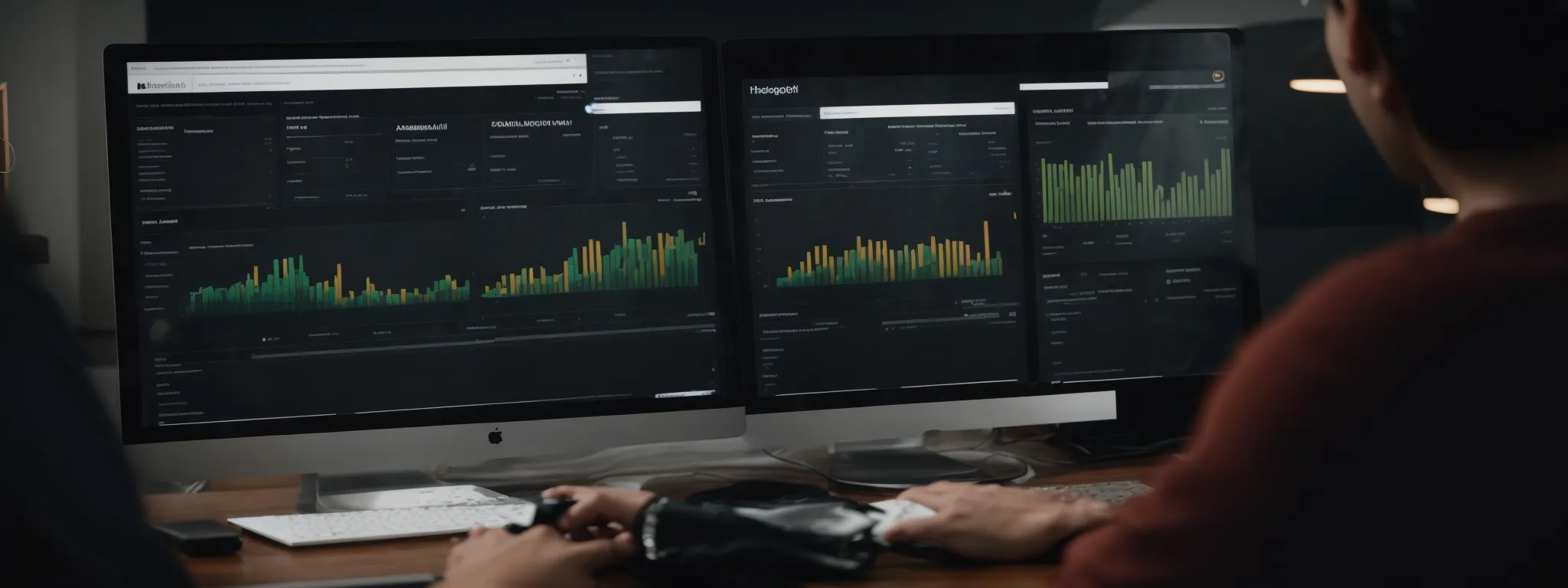Blogger’s Guide to 5-Point Technical SEO
Essential Technical SEO Strategies for Bloggers Navigating the intricacies of search engine optimization often seems daunting, yet it is undeniably critical for bloggers aiming to increase their […]
Essential Technical SEO Strategies for Bloggers
Navigating the intricacies of search engine optimization often seems daunting, yet it is undeniably critical for bloggers aiming to increase their online visibility.
Technical SEO, a cornerstone of a holistic digital strategy, lays the groundwork for search engines to crawl, index, and serve content to the audience with precision.
Reflective of this is the focus on optimizing site speed, ensuring secure data transmission, and crafting a responsive design, all of which are vital in elevating a blog’s position on search engine result pages.
Tailoring a site to communicate effectively with search bots requires a blend of tactical expertise and a profound understanding of SEO best practices.
Keep reading to discover actionable technical SEO strategies that can transform a blog’s performance and cement its digital presence.
Key Takeaways
- Technical SEO Is a Fundamental Component for Bloggers to Enhance Site Visibility and User Experience
- Implementing Responsive Design and Optimizing Server Response Times Positively Impact SERP Rankings and User Satisfaction
- Utilizing SearchAtlas SEO Software and LinkGraph’s SEO Services Can Advance Content Discoverability and Site Performance
- SSL Certificates Are Essential for Establishing Trust and Security, Elevating the Blog’s Credibility and SEO Strength
- Structured Data Markup Like Schema Helps in Achieving Accurate Search Results and Increasing Visibility and CTR for Bloggers
Understanding Technical SEO for Blogging Success

In the digital landscape, bloggers must navigate an ever-evolving terrain of search engine algorithms to ensure their content reaches the intended audience.
Technical SEO stands as a pillar in this quest, serving as the bedrock for enhancing blog visibility and user experience.
This facet of search engine optimization delves into the intricate web of site architecture, ensuring search engines can seamlessly discover, index, and render web pages.
Recognizing the critical role of Technical SEO Empowers Bloggers to optimize their digital content, addressing both the overt and nuanced elements that influence their site’s performance in search engine result pages (SERPs).
What Is Technical SEO and Why It Matters for Bloggers
Technical SEO encompasses the behind-the-scenes aspects of web optimization that enable search engine spiders to crawl and index a blog effectively. It includes optimizing the blog’s infrastructure, such as URL structure, response times, and the implementation of SSL certificates, which collectively enhance site accessibility and security.
For bloggers, Mastering Technical SEO is pivotal in securing a digital foothold. An optimized technical framework not only garners favor with search engines like Google but also provides readers with an improved browsing experience, increasing the chances of return visits and social shares:
| Technical Element | Benefit to Blogger | Impact on User Experience |
|---|---|---|
| Responsive Design | Improved SERP rankings | Seamless viewing on any device |
| Fast Server Response Time | Lower Bounce Rate | Quick page loading enhances satisfaction |
| Optimized URL Structure | Easier Content Indexing | Intuitive navigation and understanding of site hierarchy |
Enhancing Blog Structure for SEO Efficiency

For bloggers aiming to carve out a competitive niche in the digital ecosystem, a meticulous approach to technical SEO is non-negotiable.
Integral to this is the enhancement of the blog’s very foundation, where URL structures must be crafted not only for clarity’s sake but also to align with search engines’ ranking criteria.
Similarly, the strategic use of category and tag pages facilitates a more organized content delivery system, bolstering SEO effectiveness.
Attuned to these pivotal factors, bloggers position their digital offerings for improved discoverability, setting the stage for sustainable online success.
Optimizing URL Structures for Better Ranking
Optimization of URL Structures is a critical step for bloggers intent on improving their search engine rankings. Through the implementation of clear, concise, and keyword-rich URLs, a blog’s content becomes more accessible to search algorithms, ensuring each post has the potential to rank higher on SERPs. This practice leads to URLs that contribute positively to a site’s overall SEO profile and resonate with the clarity searchers and search bots require.
LinkGraph’s SEO Services pay close attention to these details, incorporating best practices in URL optimization to result in more effective indexing and categorization of blog content. With the help of SearchAtlas SEO software, bloggers can refine their URL structures to achieve greater visibility and fortify their SEO strategy, enabling each blog post to serve as a cogent beacon to guide users through the digital expanse.
Implementing Category and Tag Pages Smartly
Smart implementation of category and tag pages can dramatically Streamline the SEO Process for bloggers. By systematically organizing content under relevant categories and tags, bloggers pave the way for search engines to understand and rank their niche-specific content efficiently.
Moreover, when coupled with LinkGraph’s SEO services, the strategic application of Categorization Enhances Visibility and simplifies user navigation. This ultimately fosters a more engaging platform where content is not just found, but readily consumed:
- Analyze existing content to identify core themes for category creation.
- Use specific, non-overlapping tags to accurately depict post topics.
- Leverage LinkGraph’s free SEO audit to refine category and tag utilization.
Improving Site Speed as a Ranking Factor

In the pursuit of digital prominence, bloggers must not overlook the significance of site speed, which has emerged as a salient ranking factor within the intricate matrix of search engine optimization.
By minimizing page load times, bloggers can vastly improve user experience, consequently boosting visitor retention and conversion rates.
Embracing a portfolio of techniques that encompasses leveraging browser caching and integrating content delivery networks, adept bloggers can optimize their sites for brisk and responsive interactions, ensuring both search engines and users are greeted with superior website performance.
Minimizing Page Load Times to Boost User Experience
Achieving brevity in page load times stands as a non-negotiable in today’s fast-paced digital milieu, with user expectations at an all-time high. LinkGraph’s SEO services conscientiously target this aspect, optimizing blog posts to ensure swift loading that caters to the impatient rhythms of modern web users and coincides with search engine demands for speed.
Utilization of SearchAtlas SEO software propels this endeavor by identifying elements that impede site performance, enabling strategic enhancements that significantly elevate user experience. Through diligent adjustments and ongoing monitoring, LinkGraph ensures bloggers’ content is ingested by users with minimal delay, reinforcing retention and engendering loyalty.
Leveraging Browser Caching and Content Delivery Networks
Bloggers seeking to improve their SERP standings invariably turn to strategies such as leveraging browser caching and Employing Content Delivery Networks (CDNs). Browser caching stores elements of a blog locally in a visitor’s browser, thereby reducing load times on subsequent visits, while CDNs distribute the blog’s content across a network of servers, minimizing the distance data must travel to reach the user. These sophisticated, yet practical approaches are critical in enhancing site speed and overall user experience.
Implementing browser caching and CDNs demands a technical acumen that professionals at LinkGraph provide through their comprehensive SEO services. By utilizing such tactics, LinkGraph assists bloggers in cutting down page load times markedly, a move that not only elevates a blog’s usability for returning visitors but also signals to search engines the blog’s commitment to a swift and efficient user experience, a decisive factor in today’s competitive search landscape.
Securing Your Blog With HTTPS Encryption

In the landscape of digital authorship, bloggers recognize the growing necessity of shielding their creative endeavours with robust security measures.
Emphasizing the importance of SSL certificates is not just about fortifying a blog against online threats; it’s about cementing trust with the audience and solidifying the blog’s standings in the competitive sphere of SEO.
As search engines increasingly favor secure connections, integrating HTTPS is a cornerstone strategy for bloggers who aim to demonstrate credibility, safeguard their readers’ information, and optimize their presence in search engine rankings.
The Importance of SSL Certificates for SEO and Trust
In today’s cyber-centric world, the impetus for bloggers to adopt HTTPS Encryption cannot be overstated. SSL certificates serve as a stamp of authenticity and security for a blog, indicating to users and search engines alike that the website is a trustworthy source of information.
The implementation of SSL certificates directly influences a blog’s SEO strength, promoting better rankings in search engine results as Google places a premium on user security. Trust, integral to fostering a loyal readership, is hence fortified by the assurance of encrypted connections, cementing the blog’s reputation and credibility.
- Invest in an SSL certificate to signal to visitors and search engines the site’s security.
- Convert the blog to HTTPS to bolster its trustworthiness and SEO rankings.
Mobile Optimization for Increasing Organic Traffic

In an era where mobile devices are ubiquitous, bloggers must prioritize mobile optimization to attract and retain a growing audience that predominantly accesses content on the go.
Recognizing this shift in user behavior is imperative for those seeking to expand their organic traffic and remain relevant in the digital age.
Implementing responsive design ensures a blog’s interface adapts fluidly across diverse screen sizes, providing a seamless reading experience that is both user-centric and favored by search engines.
This approach is vital for bloggers to maintain an edge in an increasingly mobile-first world.
Making Your Blog Mobile-Friendly With Responsive Design
Adopting responsive design is more than a convenience—it’s a necessity for bloggers keen on catering to a mobile audience. LinkGraph’s SEO services recognize that a mobile-friendly blog resonates deeply with users and search algorithms, ensuring the blog remains approachable, relevant, and primed for higher search rankings.
Through the implementation of responsive design techniques, LinkGraph ensures that every blog maintains functional elegance across all devices. This attention to mobile optimization underscores the significance of seamless user experiences, which are directly correlated to increased organic traffic and improved search engine positioning.
Leveraging the Power of Structured Data Markup

In the landscape of search engine optimization, Structured Data Markup stands as a pivotal yet often underutilized tool at a blogger’s disposal.
Commonly known as Schema Markup, this powerful form of microdata creates a stronger dialogue between a blog and search engine crawlers.
Applying Schema Markup enables bloggers to meticulously convey the semantics behind their content, thereby enhancing the search engines’ ability to parse and display data in rich, informative snippets.
Embracing this intricate layer of technical SEO allows bloggers to optimize their online presence, ensuring their content is interpreted correctly and displayed prominently in search results, enriching user interaction with their digital offerings.
How Schema Markup Helps Search Engines Understand Your Content
Schema Markup operates as a powerful tool for content clarity, enhancing communication between blogs and search engine crawlers. It provides explicit cues to search engines about the meaning and context of page content, which in turn supports the accuracy of search results.
By integrating structured data, bloggers can ensure that their content is not only indexed but is also eligible for rich results, increasing visibility and potentially elevating click-through rates (CTR). This precise transmission of data augments content discoverability and assists in delivering a compelling argument for the value of a blog’s content:
| SEO Feature | Role of Schema Markup | Benefits to Bloggers |
|---|---|---|
| Rich Snippets | Enhances search result displays | Improves CTR and visibility |
| Content Contextualization | Conveys precise topical signals | Facilitates relevant indexing |
| Search Relevance | Provides metadata for search queries | Increases the likelihood of content matching searchers’ intent |
Identifying and Correcting Crawl Errors

Bloggers who aspire to claim their space on the front pages of search results must master the art of seamless site performance.
Crucial to this mastery is the detection and resolution of crawl errors, which can impede search engines from indexing valuable content effectively.
Utilizing Google Search Console, bloggers are empowered to pinpoint and rectify these indexing issues, thereby safeguarding the integrity of their digital presence and ensuring maximum visibility across search engines.
This meticulous approach to technical SEO is essential for bloggers to maintain optimal website health and sustain their competitiveness within the digital arena.
Using Google Search Console to Find and Fix Indexing Issues
Google Search Console serves as a crucial tool for bloggers to uncover crawl errors, which are issues that prevent Google’s bots from accessing and indexing web pages. Addressing these errors promptly ensures that all valuable content has the chance to rank in search engine results, maximizing the blog’s visibility.
Once identified through the Search Console, these indexing discrepancies can be systematically resolved, bolstering the blog’s stature in the digital domain. The resolution process improves not only the user experience but also the blog’s credibility in the eyes of search engines, solidifying its SEO foundation:
- Review the Coverage report in Google Search Console for error notifications.
- Analyze the listed crawl errors and understand their root causes.
- Implement the necessary fixes and submit the URLs for re-crawling.
The implementation of such corrections is indicative of a proactive stance towards technical SEO maintenance, crucial for sustaining and elevating a blog’s reach.
Conclusion
In conclusion, bloggers must prioritize essential technical SEO strategies to achieve success in the competitive digital landscape.
Effective technical SEO ensures blogs are accessible, secure, and user-friendly, leading to improved search engine rankings and enhanced reader engagement.
Key tactics include optimizing URL structures for clarity and SEO benefit, smartly utilizing category and tag pages for better organization, boosting site speed through minimizing load times and leveraging browser caching and CDNs, securing sites with SSL certificates to establish trust, ensuring mobile responsiveness for a growing on-the-go audience, and employing structured data markup to help search engines understand and properly display content.
Additionally, identifying and correcting crawl errors with tools like Google Search Console is critical to maintain optimal website health.
By implementing these strategies, bloggers can strengthen their SEO foundation, increase their visibility, and build a more robust digital presence.















































































